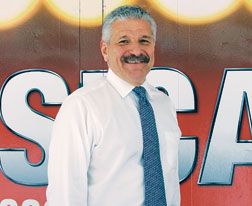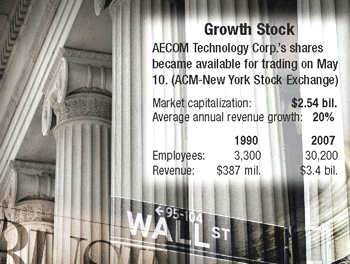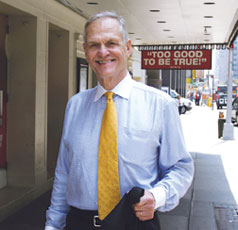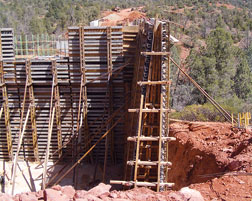 Guy Lawrence/ENR AECOM CEO John M. Dionisio says that nothing changes now that AECOMs successful IPO is completed.
|
As most employee investors now know, one lesson of the Enron debacle in 2001 was never to keep too much of your own money tied up in your company’s stock. Last month, on May 10, hundreds of employees of AECOM Technology Corp. sold off $223 million worth of stock, after commissions and discounts for underwriters, during the company’s initial public offering. More significantly, thousands of other employee-shareholders held on to a far greater portion of AECOM stock, worth more than $1 billion. Frederick W. Werner, CEO of the Los Angeles-based firm’s Americas Transportation Group, sold only 11,061 of his 371,444 total shares.
For some, the feeling of financial security and the possibility of much greater gains in the future by selling stock on the open market was palpable. According to one source, when the wife of one company manager had her wallet stolen during a trip just after the IPO, her husband consoled her this way: “We just made it up on AECOM stock.”
| multimedia | |
|
|
podcast John M. Dionisio and Richard G. Newman: AECOM's Successful IPO Listen >> |
In fact, May 10 may become a key milestone in AECOM’s history as an employee-owned firm, and it may be an equally significant mark in Wall Street’s on-again, off-again romance with engineering and construction.
On that day, AECOM and its underwriters completed the IPO with an unexpected flourish: The maximum number of shares sold. Until then, the company’s stock was 75% employee-owned, spurred by a generous 18% company stock match for employees. A much smaller piece was owned by private equity investors. In essence, AECOM and its employee stockholders and private investors sold equity valued at $809 million in a company whose market cap one month after the IPO is about $2.5 billion. Mutual funds, pension funds and other institutional investors pounced on the stock at the high end of its announced IPO pricing range, $20 per share. That left more than half the stock still in employee hands. CEO John M. Dionisio terms the event “historic” and “momentous.”
 |
The founding executives of AECOM had been buying the company’s stock since it was spun off from Ashland Inc. in 1990. Employee ownership became the lifeblood source of capital. When a voluntary lockup period for many top shareholders expires, they will be free to sell off more of their AECOM stock and diversify their investments. With 10,000 shareholders, the amount of wealth involved is considerable. “Very few companies do IPOs that have our breadth of ownership,” says Michael Burke, the company’s chief financial officer. “We had responsibility for those people’s personal wealth,” adds Dionisio.
 Guy Lawrence/ENR Newman says Enron backlash was a worry prior to first IPO try.
|
First IPO Attempt Postponed
In 2003, AECOM tried to use an IPO to raise about $160 million but pulled the offering before launching the road show for investors. Investors “were apparently more interested in management consultants,” such as KPMG Consulting and Accenture, says one engineering and construction executive. The IPO market was too skittish and employees didn’t want to go ahead with the offering, says Richard G. Newman, AECOM’s chairman.
Less than four years later, much has changed. Private equity firms have rediscovered the industry’s financial benefits and stock investors in general seem interested in nuts-and-bolts companies with good stories to tell. In November, Halliburton Co. was able to spin off 19% of KBR Inc., raising $508 million in an IPO. Even a slowing housing market hasn’t dampened the engineering and construction sector’s potential in infrastructure, environmental and government services markets.
AECOM’s own tale is jam-packed. Size is one advantage. The firm had 2006 revenue of $3.4 billion and 30,200 employees. Its 20% average annual growth is split about evenly between organic and acquisitions. The company also has a broad international footprint, rich market segments and longtime managers and staff, who also invested heavily.
Like other construction industry firms now becoming supersized, AECOM built itself into a megastore for professional and technical services. “We are fully integrated and global and able to say we could compete and win any project we go after,” says Dionisio. Adds Newman: “Economic development with environmental sensitivity, that’s our sweet spot.”
Investment analysts have not had time to publish reports on AECOM since the IPO, but at least one seemed impressed with the company’s prospects, even before the IPO. Internet blogger Bill Simpson, writing on tradingipos.com, saw great potential in AECOM based on an estimate that the firm would go public at $19 per share, not at the actual $20 figure. AECOM “is much stronger than KBR simply due to its ability to grow revenue [and the bottom line] going forward,” he wrote.
“Right now, all the stars lined up,” Dionisio says. The financial stars also are aligning for longtime managers, including top executives who are among the best-compensated in the industry by virtue of AECOM’s size and record. Senior managers and the biggest shareholders agreed to voluntary lockup of their stock for 180 days after the IPO. But shares have already started to rise in value, indicating a potential windfall after the lock-up period expires.
Dionisio, 58, is a New York City-born engineer who has worked at AECOM and its predecessor companies for 35 years. He assumed most CEO duties in 2006 from the 73-year-old Newman, who was born in nearby Yonkers. In 2006, AECOM’s board paid Newman $900,000 in annual salary, with Dionisio earning $719,000, according to the firm’s stock prospectus. Each received an $850,000 bonus. But Dionisio’s overall compensation was $3.37 million, about $160,000 more than Newman’s, with stock awards and other benefits factored in.
 AECOM/Jennifer Bixby Sedona, Ariz., road job typifies AECOM projects.
|
Big Potential Payoff
But the big payoff for Dionisio, Newman and dozens of other top managers could still be ahead. The two executives and Chief Operating Officer James R. Royer have hundreds of thousands of unexercised stock options that allow them to buy in the $5 to $10 range, and that could provide them many millions of dollars more in personal gains over the next few years and possibly create more millionaires on staff.
However, it also is possible that if AECOM slips up, Wall Street and investors will punish the stock and drive it down. Those swings are part of the company’s life now. “There’s more downside risk but also more upside opportunity,” says Scott Kolbrenner, a director of Houlihan Lokey, the Los Angeles investment banker that worked with AECOM on private-placement financing.
Early in AECOM’s existence, top managers realized that a day would come when retiring employees could exceed new hires, and the increasing value of company stock would put it in a financial bind. The same trend and the need to recapitalize to allow managers and employees to cash out and retire is sweeping the industry.
By late 2001, AECOM had another concern: backlash to the Enron scandal. “Enron unfortunately created a lot of problems for employees...with our Congress starting to talk about possibly limiting the amount they could invest in their own companies,” says Newman. “This concerned us because a good part of our capital was...

Post a comment to this article
Report Abusive Comment